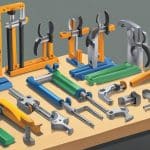Types Of Pliers
Pliers are an essential tool in any toolbox, whether you are a professional or a DIY enthusiast. They are used to grip, twist, cut, and bend various materials, making them versatile and useful for a wide range of applications. However, not all pliers are created equal, and it is important to understand the different types of pliers available and their uses.
The fundamentals of pliers include the jaws, handles, and pivot point. The jaws are the part of the pliers that grip and manipulate the materials, while the handles provide the user with a comfortable grip. The pivot point is the joint that connects the jaws and handles, allowing the pliers to open and close. Understanding the fundamentals of pliers is crucial in choosing the right tool for the job.
There are various types of pliers available, each designed for a specific task. Some of the most common types of pliers include slip-joint pliers, needle-nose pliers, and locking pliers. Specialized pliers such as wire strippers, crimping pliers, and snap ring pliers are also available for more specific tasks. By understanding the different types of pliers and their uses, you can ensure that you have the right tool for the job, making your work easier and more efficient.
Key Takeaways
- Pliers are a versatile tool used to grip, twist, cut, and bend various materials.
- Understanding the fundamentals of pliers is crucial in choosing the right tool for the job.
- Different types of pliers are available, each designed for a specific task, and specialized pliers are also available for more specific tasks.
Fundamentals of Pliers

Design and Mechanics
Pliers are hand-held tools that are used for gripping, bending, and cutting objects. They consist of two handles, two jaws, a pivot, and a fulcrum. The jaws are designed to grip objects, while the pivot and fulcrum allow the user to apply force to the object. The handles are where the user applies the force to operate the pliers.
The design of pliers can vary depending on their intended use. Some pliers have long, narrow jaws for reaching into tight spaces, while others have wide jaws for gripping larger objects. The handles can also vary in size and shape to accommodate different hand sizes and grip preferences.
One of the key features of pliers is their ability to apply force in a controlled manner. The pivot and fulcrum are designed to provide leverage, allowing the user to apply more force with less effort. This makes pliers ideal for tasks that require precision and control.
Common Materials and Ergonomics
Pliers are typically made from steel or other durable materials. The handles can be coated with rubber or other materials to provide a comfortable grip and reduce hand fatigue.
Ergonomics is an important consideration when selecting pliers. Pliers that are too small or too large for the user’s hand can cause discomfort and fatigue. The handles should be designed to provide a comfortable grip and reduce strain on the hand and wrist.
In addition to the size and shape of the handles, the angle of the jaws can also affect ergonomics. Pliers with angled jaws can reduce the amount of wrist rotation required to grip objects, reducing strain on the wrist.
Overall, pliers are versatile tools that can be used for a wide range of tasks. By understanding the design and mechanics of pliers, as well as their common materials and ergonomics, users can select the right pliers for their needs and use them effectively.
Types of Pliers
Pliers are versatile hand tools that come in a variety of shapes and sizes. They are used for gripping, cutting, and bending materials such as wires, pipes, and cables. Here are some of the most common types of pliers:
Slip-Joint Pliers
Slip-joint pliers are also known as adjustable pliers. They have a pivot point that can be adjusted to change the size of the jaws. This makes them useful for gripping and holding objects of different sizes. Slip-joint pliers are often used in plumbing and electrical work.
Locking Pliers
Locking pliers, also known as Vise-Grip pliers, have a locking mechanism that holds the jaws in place. This makes them useful for gripping and holding objects securely. Locking pliers come in a variety of shapes and sizes, including curved jaw and needle nose.
Needle-Nose Pliers
Needle-nose pliers, also known as long-nose pliers, have a long, narrow jaw that tapers to a point. This makes them useful for reaching into tight spaces and for precision work. Needle-nose pliers are often used in electronics and jewelry making.
Diagonal Pliers
Diagonal pliers, also known as wire cutters, have a sharp, angled jaw that is designed for cutting wires and other materials. The jaws are often serrated to provide a better grip. Diagonal pliers come in a variety of sizes and are often used in electrical work.
Tongue-and-Groove Pliers
Tongue-and-groove pliers, also known as channel-lock pliers, have a set of grooves along the jaws that allow them to adjust to different sizes. This makes them useful for gripping and holding objects of different sizes. Tongue-and-groove pliers are often used in plumbing and automotive work.
Overall, pliers are essential tools for any DIY enthusiast or professional. By understanding the different types of pliers and their uses, you can choose the right tool for the job and make your work easier and more efficient.
Specialized Pliers
When it comes to specialized pliers, there are a variety of options available for different tasks. Here are some of the most common specialized pliers and their uses:
Electrical Pliers
Electrical pliers are designed specifically for electrical work. They are used to strip and crimp wires, as well as to cut and bend them. These pliers often have insulated handles to protect the user from electric shock. Some common types of electrical pliers include wire strippers, crimping pliers, and battery pliers.
Fencing Pliers
Fencing pliers are designed for use in the construction and repair of fences. They often have a hammer head on one side for driving nails and a claw on the other side for removing them. Fencing pliers also typically have a wire cutter and a wire stretcher built into the jaws.
Hose Clamp Pliers
Hose clamp pliers are used to compress spring clamps on hoses, allowing them to be removed or installed. They come in a variety of shapes and sizes to fit different types of clamps, and often have a ratcheting mechanism to hold the clamp in place.
Snap Ring Pliers
Snap ring pliers are used to install and remove snap rings, which are small metal rings that fit into a groove on a shaft or in a bore. They come in two types: internal and external. Internal snap ring pliers are used to install and remove snap rings that are inside a bore, while external snap ring pliers are used to install and remove snap rings that are on the outside of a shaft.
Overall, specialized pliers can make specific tasks easier and more efficient. By choosing the right pliers for the job, users can save time and effort while ensuring a job well done.
Pliers in Professional Use
When it comes to professional use, pliers are an essential tool in a variety of industries, including plumbing, electrical work, carpentry, construction, automotive, and welding. Each industry requires specific types of pliers to perform various tasks effectively. Here are some of the most common industries that use pliers and the types of pliers they use.
Plumbing and Electrical Work
Electricians and plumbers use pliers to grip, twist, and cut wires, pipes, and fittings. Needle-nose pliers, slip-joint pliers, and tongue-and-groove pliers are some of the most commonly used pliers in these industries. Needle-nose pliers are ideal for reaching into tight spaces, while slip-joint pliers can adjust to different sizes of nuts and bolts. Tongue-and-groove pliers, also known as channel-lock pliers, are used to grip and turn pipes and fittings.
Carpentry and Construction
Carpenters and construction workers use pliers to grip, twist, and cut nails, screws, and wires. Linesman pliers, diagonal pliers, and end-cutting pliers are some of the most commonly used pliers in these industries. Linesman pliers are ideal for gripping and twisting wires, while diagonal pliers are used to cut wires. End-cutting pliers, also known as nippers, are used to cut nails and other materials.
Automotive and Welding
Automotive and welding industries use pliers to grip, twist, and cut wires, hoses, and fittings. Oil filter pliers, locking pliers, and welding pliers are some of the most commonly used pliers in these industries. Oil filter pliers are used to grip and turn oil filters, while locking pliers can hold objects in place. Welding pliers are used to grip and manipulate hot metal.
In conclusion, pliers are an essential tool in various industries, and each industry requires specific types of pliers to perform various tasks effectively. By understanding the different types of pliers and their uses, professionals can choose the right tool for the job and work more efficiently.
Maintenance and Safety
Cleaning and Storage
Pliers are essential tools that require regular maintenance to ensure they function properly and last longer. After use, it is recommended to clean pliers with a dry cloth to remove any dirt, dust, or debris. If the pliers are heavily soiled, a mild detergent solution can be used to clean them. After cleaning, it is important to dry the pliers thoroughly to prevent rusting.
Proper storage of pliers is also crucial in maintaining their functionality and longevity. It is recommended to store pliers in a dry place, away from moisture and humidity, to prevent rusting. Additionally, storing pliers in a tool bag or box can protect them from damage and reduce the risk of accidents.
Safety Measures
Using pliers can be dangerous if proper safety measures are not taken. One of the most important safety measures is to use pliers with insulated handles when working with electricity. Insulated handles reduce the risk of electrical shock and protect the user from accidental contact with live wires.
It is also important to use the correct type of pliers for the job to avoid damaging the tool or causing injury. For example, using pliers with teeth or serrated edges on delicate materials can cause damage or leave marks.
Lastly, it is important to wear appropriate personal protective equipment (PPE) when using pliers. This includes safety glasses to protect the eyes from flying debris and gloves to protect the hands from cuts and abrasions.
By following these maintenance and safety measures, pliers can be kept in good condition and used safely for years to come.






